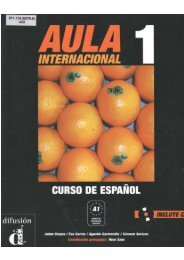III. The Beginnings of Transformation
III. The Beginnings of Transformation
III. The Beginnings of Transformation
Create successful ePaper yourself
Turn your PDF publications into a flip-book with our unique Google optimized e-Paper software.
BEGINNINGS OF TRANSFORMATION<br />
<strong>The</strong> same outcome resulted from intermarriage between the Turks and<br />
the local population. This union between Turks and Christians had<br />
already produced a new generation <strong>of</strong> Anatolians by the early twelfth<br />
century, referred to in the Greek sources as mixovarvaroi, and their presence<br />
is attested to in various Turkish armies. When Alexius was campaigning<br />
against the Turks in the district <strong>of</strong> Polybotus, a number <strong>of</strong> the army<br />
<strong>of</strong> the emir Monolycus were mixovarvaroi who spoke Greek. 246<br />
<strong>The</strong>y are<br />
2 4 7<br />
also mentioned in the army <strong>of</strong>the sultan <strong>of</strong>Konya.<br />
Certainly the most<br />
celebrated instance <strong>of</strong> this intermarriage has to do with Danishmend and<br />
his marriage to a Christian woman. 248<br />
A further example is the case <strong>of</strong><br />
Tsiaous (chavush ?) the Turkish <strong>of</strong>ficial who betrayed Sinope to Alexius.<br />
His mother was a Georgian Christian and his father, a Turk. 249<br />
twelfth-century canonist Balsamon remarks, with disapproval, that though<br />
the Georgians were Orthodox, they were giving their daughters in<br />
marriage to Agarenes. 250<br />
<strong>The</strong> mixovarvaroi from Anatolia are mentioned<br />
in a very interesting document in which Balsamon comments on canon<br />
eighty-four <strong>of</strong>the Council in Trullo. 251<br />
Though this phenomenon <strong>of</strong> intermarriage and the appearance <strong>of</strong> a<br />
new generation <strong>of</strong> mixovarvaroi is only briefly mentioned by the sources,<br />
one must assume that it was no rare or isolated occurrence. <strong>The</strong>se mixo<br />
varvaroi suffered occasionally from a dichotomy <strong>of</strong> political sympathy<br />
and allegiance, but in the long run their appearance in Anatolia resulted<br />
in a process that favored the growth <strong>of</strong> the Muslim population at the<br />
expense <strong>of</strong> the Christian population, because Muslim society dominated<br />
politically and militarily. It is interesting, but unpr<strong>of</strong>itable, to speculate<br />
about what would have happened to the Anatolian mixovarvaroi under<br />
different political circumstances.<br />
To the extent that it took place in the eleventh and twelfth centuries,<br />
conversion also had the effect <strong>of</strong> decreasing the number <strong>of</strong> Christians<br />
while increasing the Muslim population. <strong>The</strong>re is little in the way <strong>of</strong><br />
source material on the subject <strong>of</strong> conversions, but there seems to be some<br />
indication that in this period conversions to Islam were numerically<br />
significant, though not as extensive as they later were to become. <strong>The</strong><br />
Danishmendname reflects one aspect <strong>of</strong>the spirit in which the conquest <strong>of</strong><br />
much <strong>of</strong> Anatolia was made. It attributes a strong proselytizing zeal to<br />
local Christians who assist the slaves in escaping. H. Kopstein, Zur Sklaverei im ausgehenden<br />
Byzanz (Berlin, 1966), pp. 91-94.<br />
2 4 7<br />
Ibid., 207. Such, probably, were also the troops <strong>of</strong>Tzachas who beseeched the Lord<br />
(in Greek) to save them from their Greek besiegers in Chios in 1090, Ibid., II, 111.<br />
2 4 8<br />
Danishmnendname-Melik<strong>of</strong>f, I, 129. See also, I, 318, 361, for other examples. E.<br />
Rossi, Il Kitab-i-Dede Qorqut (Vatican, 1952), pp. 32-33, 181 ff.<br />
2 4 8<br />
Anna Comnena, II, 65-66.<br />
2 5 0<br />
Rhalles and Potles, I, 271-272; II, 475.<br />
2 5 1<br />
Ibid., II, 498. For their adoption <strong>of</strong> Christian baptism see chapter vii, n. 165.<br />
176<br />
<strong>The</strong>






